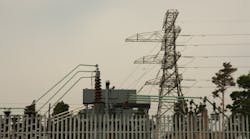Pressure is mounting in Washington for lawmakers to increase the federal government’s role in helping to protect the U.S. electric grid. Earlier this week, the Wall Street Journal reported that two research groups – the Congressional Research Service and the Battelle Memorial Institute – are urging Congress to look into the security measures currently being utilized by the nation’s utility companies to determine where things could be improved.
The physical threats facing electric utility operators were highlighted in February when an internal report from the Federal Energy Regulatory Commission was published by the WSJ detailing a sniper attack that took place at a Pacific Gas and Electric substation in California last year. In response, FERC issued a directive to the North American Electric Reliability Corporation (NERC) to develop physical security standards for grid owners and operators.
Despite the devastating consequences an attack like this could have on the power grid, it pales in comparison to the cataclysmic effect of a man-made or naturally occurring electromagnetic pulse or EMP event. According to Dr. Peter Pry, executive director of the Task Force on National and Homeland Security, an EMP could potentially wipe out 90 percent of the U.S. population if the resulting blackout lasted longer than a year.
“The congressional EMP commission on which I served calculated that within a year of blackout that knocks out the national grid, we would probably lose up to nine out of 10 Americans through starvation, disease and societal collapse,” said Pry. “The only reason we can sustain a population of 310 million Americans is technology. If you take that away, we don’t have any way of feeding, providing water or even providing communications and government for an orderly society that’s going to sustain 310 million Americans.”
Pry said that if you measure the EMP risk in terms of likelihood, then a natural event would be the greatest threat because it is inevitable that a geomagnetic super storm will impact not just the U.S., but the entire world at some point in the future. However, if you think about the threat with respect to what might be greatest to defend against, then Pry said that the aftermath of a man-made EMP, such as the detonation of a nuclear weapon, could be more devastating.
“The EMP from a nuclear weapon, the geometry of the way that works is that the EMP will propagate to the line of sight on the horizon and there’s kind of a minimum after a certain altitude so the footprint gets bigger as you go up in altitude. After about 500 kilometers, the field strength starts fading out, so there’s a maximum altitude that it can go and you could cover a whole continent with one nuclear weapon and an EMP that would destroy everything pretty much,” explained Pry. “If you’re doing an apple and oranges comparison, one geomagnetic super storm versus one nuclear EMP… the natural EMP threat wins out both in terms of likelihood and in terms of area of coverage, but where the nuclear EMP wins is in death.”
According to Pry, attempting to recover from the EMP unleashed by a nuclear weapon would be an order of magnitude greater than that of a natural event.
“The nuclear EMP does something different from the natural EMP in addition to the geomagnetic storm which is called E3 (magneto hydrodynamic) EMP. That is what an EMP from the sun is like and it has long wavelengths and it needs a long target; it will couple into communications lines, railroad tracks, etc. Anything that has long dimensions of a kilometer or more is a target for this. A nuclear weapon will do that, but in addition, it does what we call E1 which is an electromagnetic shockwave that’s a high-frequency event and has three short wavelengths. It could couple into the personal computer on your desk, if you have anything that is a meter in length it can probably couple into that like your automobile. The depth of the damage done by a nuclear EMP is deeper than what you get from the E3, so you’re destroying a lot of the small computers and electronic components. That makes recovery harder and it makes it harder to defend against.”
While most people worry more about the threats from the sun because it’s a certainty, Pry said if utilities prepared for the nuclear EMP then they would be protected against most anything, including cyber attacks and severe weather. Pry said the vulnerability of the grid boils down to a couple of key components; large-scale power transformers and the SCADA systems that run them, which could be protected using surge arrestors that would defend against an overvoltage incident as result from either an EMP of cyber attack.
“The surge arrestor doesn’t care if the overvoltage is caused by a cyber attack or by a bug that’s in a SCADA, it doesn’t care if it is from a nuclear EMP or an EMP from the sun, and it doesn’t care if the overvoltage is from collapsing power lines being knocked down by a tornado or hurricane,” added Pry. “The serious problem for recovery is not power lines getting knocked down, which is what everyone assumes, but the overvoltage from these catastrophic collapses caused by weather that cause transformers and SCADAs to get burned out. We can easily replace telephone poles and power lines, we can’t replace these other things.”
In addition to surge arrestors, Pry said grid operators should also think about using Faraday cages which is a metal box or container that can channel a pulse away from whatever is being protected, as well as locking devices. A Faraday cage, according to Pry, could even shield transformers from physical attacks such as the one that occurred at the aforementioned PG&E substation.
Pry said that repairs to the grid might be virtually impossible if electric utilities wait around and don’t take the steps necessary steps to mitigate against EMP events with some sense of urgency.
“That’s the tragedy of this whole thing and that’s why I, and others, are working so hard to try to get industry and the government to move and do something to prevent it from happening. It’s not very costly to protect critical infrastructure, we know how to protect them against so that it wouldn’t fail,” said Pry. “It’s a lot like not having a fire alarm in your house and saying, ‘well, if I don’t have a fire alarm in my house, would I be able to undo the damage if I had a fire?’ If you have a fire alarm, sprinkler or even a fire extinguisher in your house, it would be much easier to cope with that eventuality of having a fire if one did break out because you would be warned and you have things that would immediately fight against it. But, if there is no preparation and then you say ‘how hard would it be to fix the damage of my neglect?’ You could lose your whole family. It’s not an advisable thing that you can just hope to fix the damage afterwards. An ounce of prevention in this case is worth a ton of cure.”



